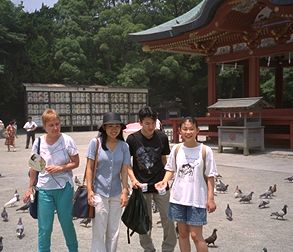
Bruce "Tog" Tognazzini.
|
|
Japan on $1000 per Day
Day 3: Budda & Broken EnglishUp early. 7:30 in the morning early. Still rested, refreshed, and ready to go. Our "jet lead" continues. Today, we will venture out of the city, bound for Kamakura, home of dozens of exquisite temples. However, first, we must pick up our Japan Rail Pass. We had paid for said pass in the United States and now, if we can only find the place to turn in our vouchers, we will actually be able to ride any train in all of Japan for two whole weeks for only $631.00 each! Now we’re talkin’ savings! The Japanese are willing to give Americans such a deal because: (a) they know we are a poor, 2nd world country and (b) they use the rail pass pick-up procedure as a way to weed out the weak and ineffectual. We are clearly instructed to go to the green window once we reach Tokyo Station to pick up our tickets. Surprise! Every window in the entire station is green! In fact, the entire station is green! You would have thought it was St. Patrick's day, except it was now 103° outside. We trudged to no fewer than 7 green windows before finally finding the correct one, in the extreme back of the station, at least a mile walk from where we had entered. We traded in our vouchers, then spent the next hour crisscrossing the station, trying to find the correct track for the train to Kamakura. Kamakura was a delight. We were met at the train by three young Japanese college students who explained that they were English majors and would be happy to take us for a tour of the area at no cost, just so they could practice their English. In any other country, we would have assumed they were thieves or assassins. In Japan, it meant that they were English majors and would be happy to take us for a tour of the area at no cost, just so they could practice their English.
We set off for a tour of the nearest noodle shop. Even though it was only 10:30 in the morning, we were famished. Or at least I was. I had ordered the $24.50 hot dog last night, but had resisted the $15.87 bun. Ramen--noodle soup--is the bargain food in Japan. It is flogged everywhere for between $5.00 to $10.00 a bowl and will keep a grown man happy and quiet for several hours at a time. We fed the five of us for less money than the cost of Julie’s room-service spaghetti, sans sauce. The highpoint of our Kamakura pilgrimage was the world-famous "outdoor budda." Actually, it was the world-famous "Daibutsu", but nobody has ever heard of that. What we all have seen is that picture of the really, really big budda settin’ out in the garden with little tiny people clustered around the base, taking pictures.
The budda is the green one in the back. This budda originally had his own house, but it was swept away by a tidal wave a while back (1495 AD) and since then he’s had to live outside. Poor Budda. Traditional Buddism has their followers dedicate their lives to reading about the Budda's experience beneath Bo tree, leading to the founding of the religion. The Japanese decided that, rather than reading about this conversion experience, they would attempt to induce it by reproducing the original serene environment. The result was the Zen—traditional Japanese—Garden, and the religious offshoot was Zen Buddism. The gardens and the religion are intricately woven together. By the way, the Kamakura college kids’ English needs work. More on that subject later. Previously: Day 2: Among the Dead and Dying (Fish)
|

